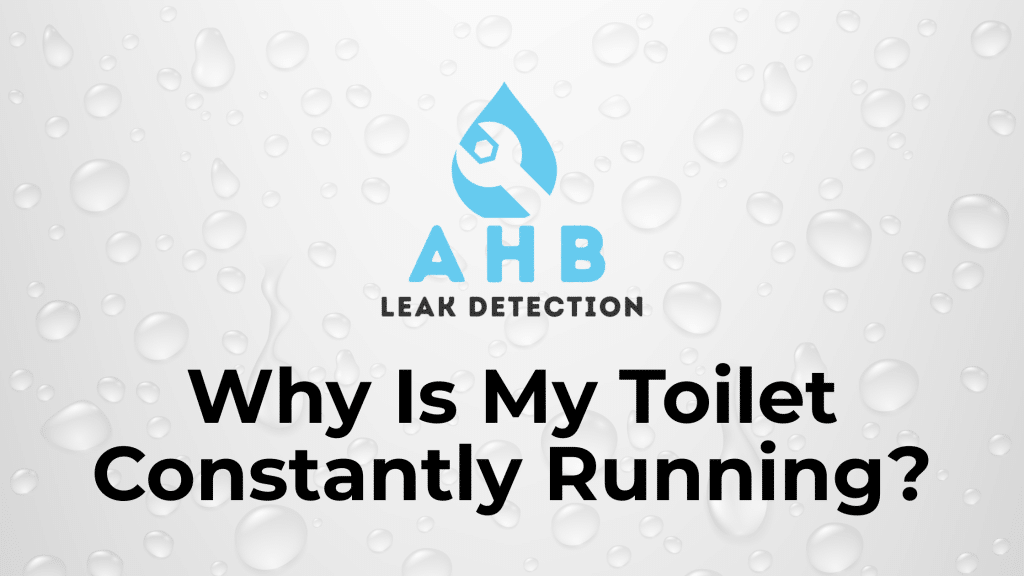Why Is My Toilet Constantly Running? Complete UK Guide to Fix It
That persistent trickle in your bathroom isn't just annoying – it's literally pouring money down the drain. A constantly running toilet wastes up to 400 litres daily, potentially adding £500+ to your annual water bill in severe cases. But here's what most UK homeowners don't realise: whilst everyone's blaming the flapper valve, the real culprit might be something completely different. After 15 years investigating water leaks across the Midlands, I'll show you exactly why your toilet won't stop running and how to fix it – properly.
A toilet constantly running water affects thousands of UK homes, wasting enough water annually to fill 15,000 bathtubs. Whether you're dealing with continuous flushing, water keeps running in the toilet bowl, or that maddening trickle that never stops, this comprehensive guide reveals the exact causes, DIY fixes, and when you need professional help. From faulty fill valves to hidden leaks, we'll diagnose why your toilet is constantly running and show you how to stop it – potentially saving hundreds on your water bill.
Quick Navigation
- Immediate Diagnosis: Why Your Toilet Won't Stop
- The 7 Most Common Causes (Ranked by Frequency)
- The Real Cost: Water Bill Impact Calculator
- Quick Fixes You Can Try Right Now
- UK Toilet Types: Siphon vs Drop Valve Solutions
- Step-by-Step Repair Guide
- Tools & Parts You'll Need
- When to Call a Professional
- Preventing Future Running Toilet Problems
- Advanced Troubleshooting
- UK Water Regulations & Your Rights
- Your Questions Answered
Immediate Diagnosis: Why Your Toilet Won't Stop Running
Right, let's get straight to it. When water keeps running in toilet systems, it's not random – there's always a specific failure point. Here's my 30-second diagnosis method that'll identify 90% of problems:
- Remove the cistern lid and check water level – is it overflowing into the overflow tube?
- Add food colouring to the cistern – does it appear in the bowl without flushing? (Indicates seal failure)
- Turn off the water supply – does the running stop immediately or continue? (Identifies supply vs drainage issues)
- Listen carefully – is it a constant trickle, intermittent filling, or continuous flow?
- Check your water meter – is it spinning with all taps off? Look for water inside water meter box too (Could indicate hidden water leak detection needed)
The sound pattern tells you everything. A constant trickle means seal failure. Intermittent filling every few minutes indicates a slow leak. Continuous loud running suggests stuck or broken flush mechanism. Write down what you observe – it'll save time whether you fix it yourself or call someone.
The 7 Most Common Causes of a Running Toilet (From My Experience)
After investigating thousands of properties across the Midlands, here's what actually causes toilet constantly running water problems, ranked by how often I encounter them:
1. Faulty Fill Valve (approximately 35% of cases)
The fill valve controls water entering your cistern. When it fails, water continuously flows, unable to shut off properly.
- Symptoms: Constant hissing sound, water level too high
- Typical age before failure: 5-7 years
- Replacement cost: £15-30 for part
2. Worn Flapper/Flush Seal (approximately 30% of cases)
The rubber seal at the bottom of your cistern deteriorates, especially in hard water areas.
- Symptoms: Silent trickle into bowl, periodic refilling
- Typical lifespan: 3-5 years in hard water
- Replacement cost: £5-20 for seal
3. Incorrect Float Height (approximately 15% of cases)
Your ballcock valve not shutting off? Usually the float's set wrong or waterlogged.
- Symptoms: Water overflowing into overflow tube
- Quick fix: Adjust float arm downward
- Cost: Free if adjustment only
4. Damaged Overflow Tube (approximately 8% of cases)
Cracks in the overflow tube cause constant drainage, triggering continuous refilling.
- Symptoms: Water level never reaches proper height
- Diagnosis: Visual inspection for cracks
- Fix: Usually requires cistern replacement
The remaining 12% includes chain tangles, mineral deposits, warped flush valves, and – surprisingly often – foreign objects dropped in the cistern. Kids' toys are a regular culprit, believe it or not.
The Real Cost: Can a Running Toilet Increase Your Water Bill?
Absolutely – and by more than you'd think. Here's what that continuous flushing toilet is actually costing you:
| Leak Severity | Daily Water Loss | Monthly Cost (UK Average) | Annual Impact |
|---|---|---|---|
| Small trickle | 100 litres | £11 | £132 |
| Steady stream | 300 litres | £33 | £396 |
| Full running | 400+ litres | £44+ | £528+ |
| Stuck open flush | 800+ litres | £88+ | £1,056+ |
*Based on average UK water rates of £3.68 per cubic metre (1,000 litres) combined supply and sewerage charges.
Quick Fixes: How to Stop a Running Toilet in the UK (Right Now)
Before you call anyone or buy parts, try these immediate fixes that work about 40% of the time. For more detailed instructions, see our guide on how to stop a running toilet bowl.
The 5-Minute Emergency Stop
If your toilet is continuously running and you need it stopped immediately:
- Turn off the isolation valve – Located behind the toilet, turn clockwise to stop water supply
- Lift the float manually – If no isolation valve, lift the float ball/cup to stop filling
- Wedge the float up – Use a wooden spoon across the cistern to hold it temporarily
The Quick Adjustment Method
- Bend the float arm downward (older ball-float systems) to lower water level
- Turn adjustment screw on fill valve (newer systems) anticlockwise to reduce level
- Adjust chain length – should have 1cm slack when flush lever is up
- Clean valve seat with white vinegar and cloth – removes mineral deposits
- Check and untangle flush chain – surprisingly common issue
These adjustments buy you time, but if the problem returns within 24 hours, you're looking at component replacement.
UK Toilet Types: Why Your Fix Depends on Your System
Here's crucial information most guides miss: UK toilets work differently than American ones. We predominantly use siphon systems, though drop valves are becoming common. Your fix depends entirely on which you have.
Siphon Flush Systems (Traditional UK)
Found in most pre-2001 UK homes. Uses a diaphragm to create suction that empties the cistern.
- Identification: Push-down handle, requires firm press, can't do partial flush
- Common fault: Split diaphragm causing weak or failed flush
- Running water cause: Usually inlet valve, rarely the siphon itself
- Repair cost: £10-20 for diaphragm kit
Drop Valve Systems (Modern UK)
Standard in post-2001 builds, similar to American toilets. Uses a flapper or tower valve.
- Identification: Button flush (single or dual), lighter action
- Common fault: Worn seal causing constant trickle
- Running water cause: Usually the flush valve seal
- Repair cost: £15-30 for seal or valve
Step-by-Step Repair Guide: How to Fix a Toilet That Keeps Running
Right, sleeves up. Here's how to fix the most common problems properly:
Replacing a Fill Valve (Most Common Fix)
When your toilet cistern constantly filling, the fill valve's usually shot. Here's the replacement process:
- Turn off water supply – Isolation valve behind toilet, or mains if necessary
- Flush toilet – Empty cistern completely
- Disconnect water supply – Have towels ready, residual water will spill
- Remove old valve – Unscrew large nut underneath cistern (outside)
- Install new valve – Follow height instructions (usually 25mm below overflow)
- Reconnect supply – Hand-tight plus quarter turn, don't overtighten
- Adjust float level – Water should stop 25mm below overflow tube top
- Test thoroughly – Flush 5 times, check for leaks
Replacing Flapper/Flush Seal
If water constantly running into toilet bowl without overflow, it's seal failure:
- Turn off and drain – As above
- Remove old seal – Usually clips or twists off
- Clean valve seat – Use fine wire wool for mineral deposits
- Fit new seal – Ensure proper alignment, no twists
- Check chain length – Minimal slack when closed
- Test with paper – Toilet paper on seat shouldn't move when sealed
Tools & Parts: What You Actually Need
Skip the expensive kits. Here's what you genuinely need for 95% of running toilet repairs:
Essential Tools
- Adjustable spanner (medium size)
- Flat-head screwdriver
- Bucket and old towels
- Rubber gloves
- Torch or phone light
Common Replacement Parts (UK Prices)
- Universal fill valve: £12-25 (Fluidmaster 400UK fits most)
- Flush valve seal: £5-15 (measure diameter first)
- Siphon diaphragm: £8-12 (various sizes)
- Complete flush valve: £20-40 (if seal alone won't fix)
- Float valve washer: £1-3 (for older ballcock systems)
Buy from plumbing merchants rather than DIY stores when possible – better quality, same price, and they'll advise on compatibility.
When to Call a Professional (And What It Means)
I fix leaks for a living, but I'll tell you straight – not every running toilet needs professional help. However, these situations do:
Call Immediately If:
- Water at base of toilet – Could indicate trace and access leak detection needed for hidden pipework
- Multiple toilets affected – Suggests mains pressure or supply issue
- Ceiling stains below bathroom – Internal leak requiring urgent attention, learn how to find a water leak inside a wall
- Toilet rocks or moves – Seal failure risking floor damage
- You've replaced parts but problem persists – Hidden issue needs diagnosis
- Water company has notified you of high usage – See what to do when Severn Trent said I have a leak
Professional Diagnosis Needed When:
Sometimes what seems like a running toilet is actually a symptom of bigger problems. If you've tried the fixes above and still have issues, you might have:
- Hidden leak in concealed cistern pipework
- Cracked porcelain (hairline cracks aren't always visible)
- Supply pipe problems causing pressure fluctuations
- Drainage issues causing bowl water level changes
Professional acoustic leak detection can identify problems without dismantling your bathroom – think of it like an X-ray for your plumbing.
Preventing Future Running Toilet Problems
Here's what I tell every customer: prevention costs pennies, repairs cost pounds. Follow this maintenance routine:
- Add food colouring test – checks seal integrity
- Clean inlet valve filter – prevents debris blockages
- Check and adjust water level – prevents overflow wear
- Inspect flush chain/cable – replace if showing wear
- Clean rim holes with wire – ensures proper bowl refill
Annual Replacement Schedule
- Every 3 years: Replace flapper seals in hard water areas
- Every 5 years: Replace fill valve (preventive)
- Every 10 years: Full mechanism overhaul
UK water hardness matters hugely. London, Birmingham, and most of the Midlands have hard water that destroys rubber seals faster. If you're in these areas, check components annually.
Advanced Troubleshooting: When Simple Fixes Don't Work
If your toilet constantly flushing or running despite replacing obvious parts, you're dealing with less common issues:
Phantom Flushing (Toilet Runs Intermittently)
Your toilet randomly runs for 30 seconds every hour? That's "phantom flushing" – slow leak triggering refill cycle.
- Cause: Usually microscopic seal damage or rim jet blockage
- Diagnosis: Dry bowl rim, wait 10 minutes, check for moisture
- Fix: Replace seal AND clean rim jets thoroughly
Won't Stop After Flush
If the toilet runs continuously only after flushing:
- Siphon systems: Diaphragm not sealing – needs replacement
- Drop valve: Flush valve stuck open – check for debris or wear
- Both types: Chain too short, preventing seal closure
Pressure-Related Running
High mains pressure can cause constant running even with new parts. Signs include:
- Loud filling noise
- Splash-back when flushing
- Multiple plumbing fixtures dripping
Solution: Install pressure reducing valve (PRV) on mains – job for a qualified plumber.
UK Water Regulations & Your Rights
Important information most people don't know about UK water regulations (full details available from the Water Regulations Advisory Scheme):
Your Legal Obligations
Under UK Water Supply (Water Fittings) Regulations 1999:
- You must fix leaking toilets "without undue delay"
- Landlords must repair promptly once notified (housing law typically requires action within reasonable timeframe)
- Continuous wastage can result in enforcement action
Your Rights
- Leak allowances: Some water companies reduce bills if you fix promptly
- Free leak detection: If meter shows continuous use, companies must investigate
- Sewerage rebates: You don't pay sewerage charges on leaked water not entering drains
Contact your water company immediately when you discover a running toilet – document the date for potential bill adjustments.
Still Can't Stop Your Toilet Running?
If you've tried everything and your toilet's still wasting water, you might have hidden pipework issues that need professional diagnosis. Our specialist leak detection equipment can identify problems without dismantling your bathroom – finding issues DIY methods miss.
Get Professional Help TodayCall 07822 024 661 or email hello@ahbleakdetection.co.uk
The Bottom Line on Constantly Running Toilets
After years investigating water leaks across the Midlands, I can tell you this: a toilet constantly running is never just "one of those things" to ignore. It's haemorrhaging water, money, and potentially causing hidden damage you'll discover months later.
In 90% of cases, it's a simple fix – usually the fill valve or flush seal. The parts cost less than a month's worth of wasted water. But here's the crucial bit: if you've replaced the obvious components and it's still running, stop throwing parts at it. You might have hidden issues that need proper diagnosis.
Whether it's water keeps running in toilet bowl, phantom flushing, or continuous filling, the fix starts with proper diagnosis. Use the tests I've outlined, identify your toilet type, and tackle it systematically. Most importantly, don't ignore it – what starts as an annoying trickle can become structural damage when seals fail completely.
And remember, whilst YouTube makes everything look easy, there's no shame in calling professionals when you're out of your depth. Better to spend on proper repair than water damage restoration.
Professional Leak Detection Services Across the Midlands
Commonly Asked Questions
Why is my toilet constantly running but there's no visible leak?
Silent internal leaks are the most common cause. Water trickling from the cistern into the bowl won’t show externally. Perform the food colouring test: add drops to your cistern, wait 15 minutes without flushing. If colour appears in the bowl, you have an internal seal leak that needs fixing.
How do I stop my toilet from constantly running UK?
First, try the quick fixes: adjust the float level downward, clean the valve seat, check chain length (should have 1cm slack). If these don’t work, you’ll need to replace either the fill valve (£15-30) or flush seal (£5-20). Turn off your isolation valve behind the toilet to stop water waste whilst you get parts.
Why does my toilet run every 5-10 minutes (phantom flushing)?
This indicates a slow leak dropping the water level until the fill valve triggers a refill. Each phantom flush wastes about 4 litres. It’s usually caused by a deteriorating flush seal, especially in hard water areas. Replace the seal to stop this cycle.
Can a running toilet significantly increase my water bill?
Absolutely. A continuously running toilet can waste 400+ litres daily, adding £44+ monthly to your bill. Severe cases with stuck-open flush valves waste 800+ litres daily, potentially costing over £1,000 annually. Even a small trickle costs £11 monthly.
What's the most common cause of a constantly running toilet?
From my experience across thousands of Midlands properties: faulty fill valves (35%), worn flush seals (30%), incorrect float height (15%), and damaged overflow tubes (8%). In UK homes with older siphon systems, it’s usually the fill valve; in modern drop-valve toilets, it’s typically the flush seal.
How to diagnose why my toilet keeps running?
Follow this sequence: 1) Check if water’s overflowing into the overflow tube (float problem), 2) Do the dye test for seal leaks, 3) Turn off water supply – if running continues, it’s a seal issue; if it stops, it’s a fill valve problem, 4) Listen to the sound – hissing means fill valve, trickling means seal leak.
Is a running toilet a plumbing emergency?
Not immediately, but it becomes urgent if: water appears at the toilet base, multiple toilets are affected, you see ceiling stains below, or your water company notifies you of excessive usage. These indicate potential structural damage or hidden leaks requiring immediate professional attention.
How much water does a constantly running toilet waste UK?
Depends on severity: small trickle (100L daily), steady stream (300L daily), full running (400L+ daily), stuck flush valve (800L+ daily). That’s equivalent to 2-16 bathtubs of water every single day going straight down the drain.
Should I turn my water off if my toilet won't stop running?
Yes, use the isolation valve behind your toilet (turn clockwise) as a temporary measure. If there’s no isolation valve, lift and wedge the float to stop filling. This prevents water waste and potential overflow whilst you arrange repairs, but fix within 24 hours to prevent component damage.
Why does my toilet randomly run for 30 seconds?
That’s phantom flushing – your toilet is slowly leaking water from the cistern to bowl, triggering periodic refills. It’s not random; it’s cyclical based on leak rate. Usually indicates a worn flush seal or, less commonly, a hairline crack in the overflow tube.



